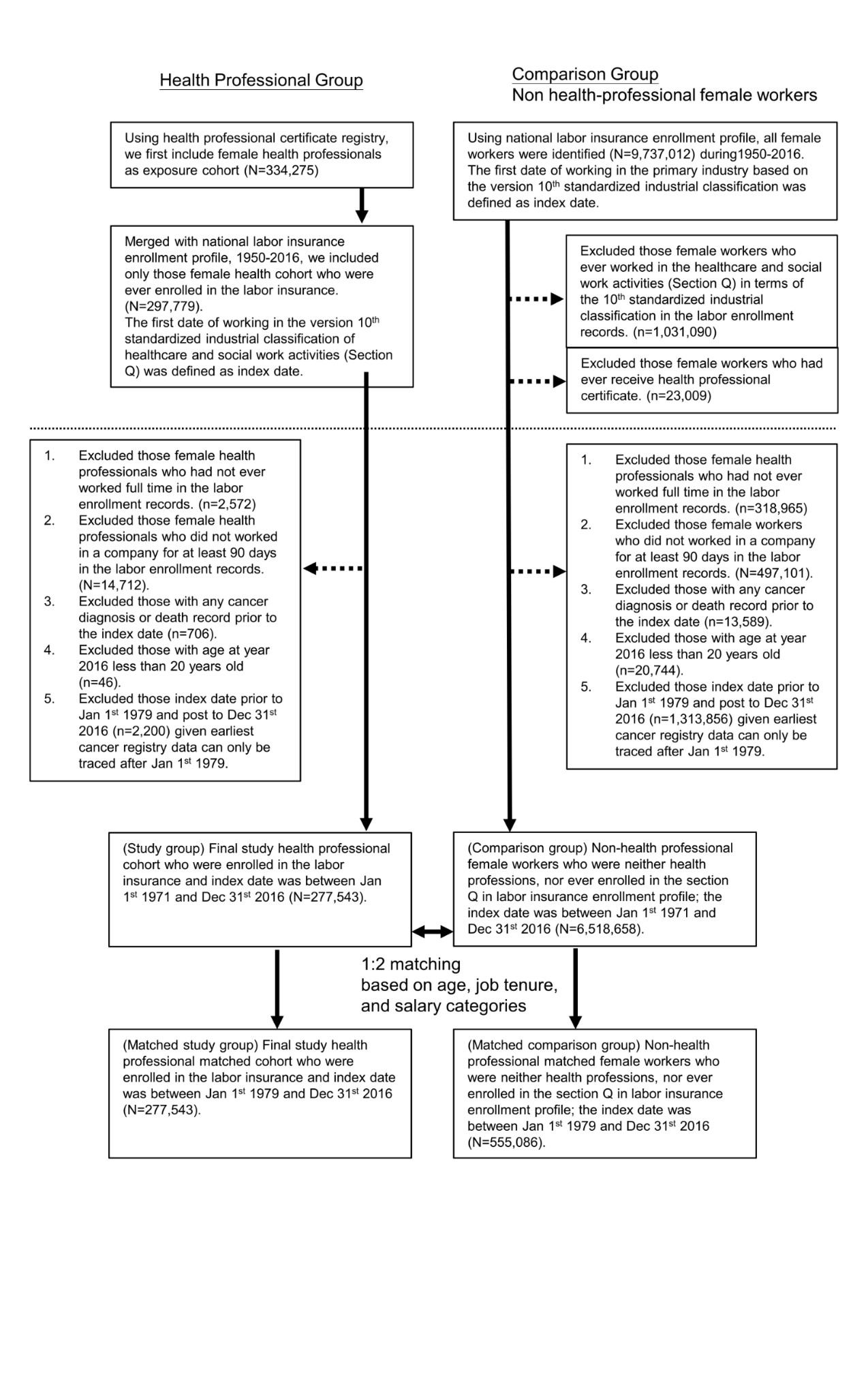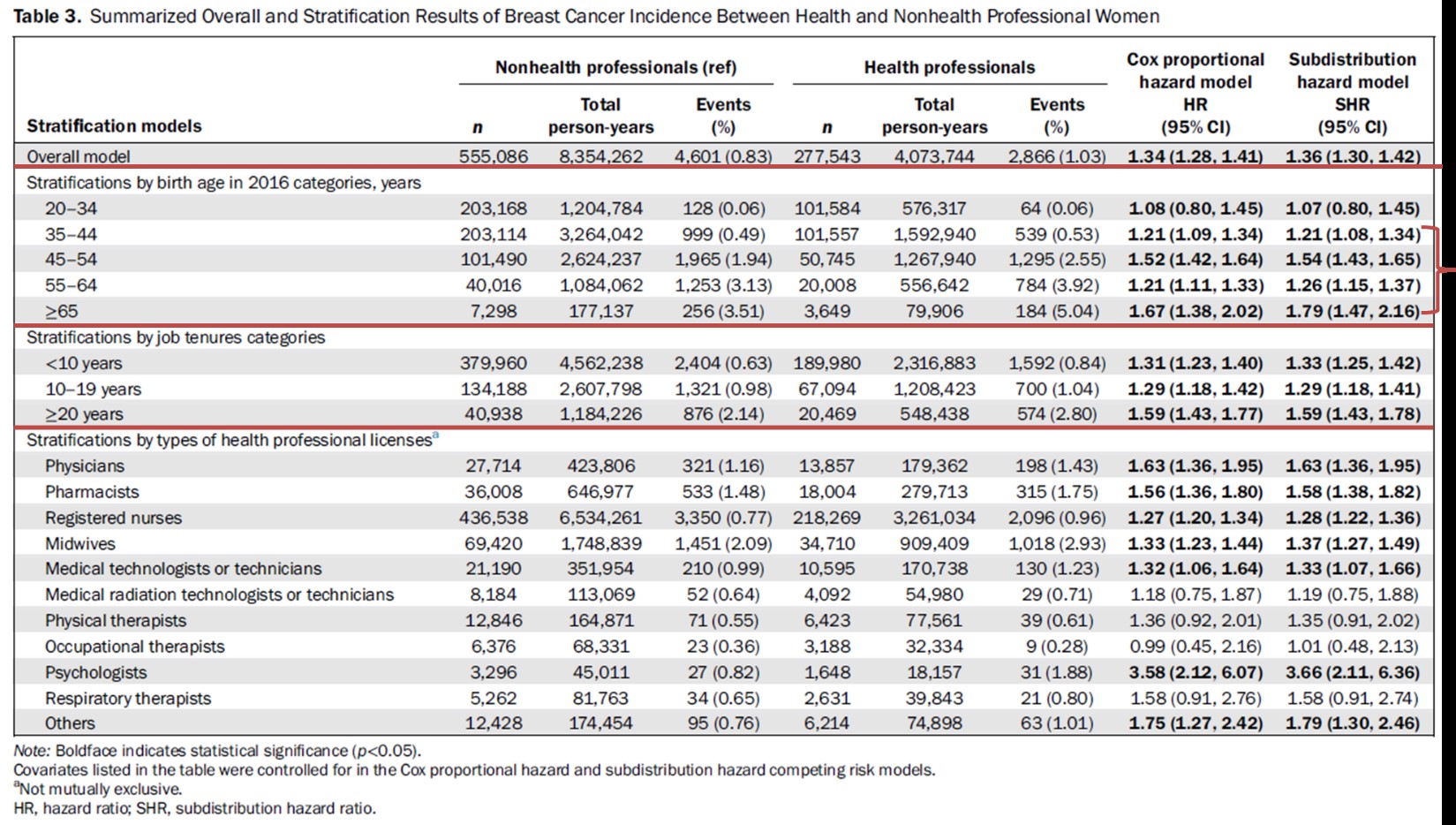女性醫療專業人員乳癌風險分析:分析35年的勞工保險和癌症登記資料縱貫性世代追蹤研究
女性醫療專業人員乳癌風險分析:分析35年的勞工保險和癌症登記資料縱貫性世代追蹤研究
乳癌造成女性癌症發生和死亡的常見風險疾病,過去對於女性醫療專業工作者的乳癌風險評估,主要是針對護理人員,較少分析其他專業人員。本研究利用35年的勞工保險和癌登資料進行縱貫性世代追蹤研究,比較277,543名女性醫療專業人員和其他配對年齡性別後共555,086名非醫療專業人員的乳癌發生風險。研究發現,相較其他非醫療專業人員,女性醫療專業人員的乳癌風險較高,約1.34倍(95%CI=1.28-1.41),考慮與死亡的競爭風險後,乳癌風險增加約1.36倍(95%CI=1.30-1.42)。除此之外,乳癌風險與年齡、工作年資、醫療執業類別相關,特別是女性醫師、護理師、藥師、助產士、醫療技術師和心理師。研究建議年度例行的身體健康檢查應納入乳癌篩檢,女性醫療專業人員若小於45歲應接受常規的乳房超音波檢查,大於45歲則應常規接受乳房X光攝影檢查。
圖形摘要



應用與亮點:
1. 本研究利用長達35年的大數據資料長期追蹤分析女性醫療專業與非醫療專業人員乳癌風險,提供實證數據了解女性醫療專業人員的乳癌風險較高。探討可能的職業暴露來源來自於夜間工作、長期工作壓力、化學毒性藥物暴露以及晚婚等造成的相關風險。
2. 研究呈現女性醫療專業人員罹患乳癌的期別相對為早期癌症,不過女性醫師和藥師則與非醫療專業人員無差異。應加強鼓勵女性醫療專業人員常規接受乳癌篩檢,以早期發現早期治療,提升存活率。
【研究團隊】
團隊成員: 謝慧敏、沈政廷、潘致弘、吳明蒼、莊昀璇
代表單位:高雄醫學大學大數據研究中心與精準環境醫學研究中心
研究聯繫Email:hsiehhm@gmail.com
【論文資訊】
論文出處:
Shen, C.T., Hsieh, H.M.*, Pan, C.H., Wu, M.T., and Chuang, Y.S. (2021). “Breast Cancer Risks among Female Health Professionals: a 35-year Population-Based Longitudinal Cohort Study in Taiwan”, American Journal of Preventive Medicine, 61(6): 831-840. (SSCI/SCI, IF=5.043, ranking=13/176, public, environmental and occupational health)
全文下載:(網址)
https://pubmed.ncbi.nlm.nih.gov/34384653/
Breast Cancer Risk Among Female Health Professionals: A 35-Year Population-Based Longitudinal Cohort Study in Taiwan
Breast Cancer Risk Among Female Health Professionals: A 35-Year Population-Based Longitudinal Cohort Study in Taiwan
Breast cancer is the most frequently diagnosed cancer among women worldwide. Previous studies have found a higher risk in nurses but no clear relationship among other health professionals. This study aims to investigate the risks of incident breast cancer among female health professionals compared with that among nonhealth professionals in Taiwan. This longitudinal observational cohort study included >35 years (1979-2016) of data from 4 nationwide population-based databases in Taiwan and identified matched cohorts with 1-to-2 propensity score matching between 277,543 health professionals and 555,086 nonhealth professionals. This study calculated total person-years for study subjects and compared breast cancer incidence between matched health and nonhealth professionals. Multivariable Cox proportional hazards and competing risk analyses were used, stratified by birth age, job tenure categories, and types of health professional license. Statistical analyses were conducted in 2019-2020. Health professionals had a significantly higher risk of breast cancer (hazard ratio=1.34, 95% CI=1.28-1.41; subdistribution hazard ratio=1.36, 95% CI=1.30, 1.42). Elevated risk of breast cancer incidence was associated with birth age, job tenure, and several health professional license types, including physician, pharmacist, registered nurse, midwife, medical technologist, and psychologist. Elevated breast cancer risk was found overall in female health professionals. Regular ultrasonography for younger women and mammography for those aged >45 years may be necessary in the annual labor physical examination for female health professionals.
Graphical Abstract



Application and Highlights:
1.This study analyzed >35 years of population-based data and found a significantly higher risk of breast cancer among female health
professionals. Occupational health policy intervention may be necessary to further prevent breast cancer risk among female health
professionals.
2.Regular ultrasonography for younger women or mammography for women aged >45 years may be necessary in the annual labor physical
examination for female health professionals.
Research Team Members: Hui-Min Hsieh, Cheng-Ting Shen, Chih-Hong Pan, Ming-Tsang Wu, Yun-Shiuan Chuang
Representative Department: Center for Big Data Research and Research Center for Precision Environmental Medicine, Kaohsiung Medical University
Contact Email: hsiehhm@gmail.com
Publication: Shen, C.T., Hsieh, H.M.*, Pan, C.H., Wu, M.T., and Chuang, Y.S. (2021). “Breast Cancer Risks among Female Health Professionals: a 35-year Population-Based Longitudinal Cohort Study in Taiwan”, American Journal of Preventive Medicine, 61(6): 831-840.
Full-Text Article: https://pubmed.ncbi.nlm.nih.gov/34384653/



